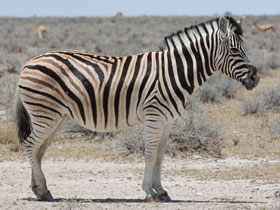The quagga (Equus quagga quagga)
 The quagga (Equus quagga quagga) is listed as "extinct" in the IUCN Red List
The quagga (Equus quagga quagga) is listed as "extinct" in the IUCN Red List
The quagga (/ˈkwɑːxɑː/ or /ˈkwæɡə/) (Equus quagga quagga) is an extinct subspecies of the plains zebra that was endemic to South Africa until it was hunted to extinction in the late 19th century. It was long thought to be a distinct species, but early genetic studies have supported it being a subspecies of plains zebra. A more recent study suggested that it was the southernmost cline or ecotype of the species.
Taxonomy
It has been historically suggested that the name quagga is derived from the Khoikhoi word for zebra (cf. Tshwa llkoaah 'zebra'), thereby being an onomatopoeic word, resembling the quagga's call, variously transcribed as "kwa-ha-ha", "kwahaah", or "oug-ga". The name is still used colloquially for the plains zebra.
The quagga was originally classified as a distinct species, Equus quagga, in 1778 by Dutch naturalist Pieter Boddaert. Traditionally, the quagga and the other plains and mountain zebras were placed in the subgenus Hippotigris. Much debate has occurred over the status of the quagga in relation to the plains zebra. The British zoologist Reginald Innes Pocock in 1902 was perhaps the first to suggest that the quagga was a subspecies of the plains zebra. As the quagga was scientifically described and named before the plains zebra, the trinomial name for the quagga becomes E. quagga quagga under this scheme, and the other subspecies of the plains zebra are placed under E. quagga, as well.
Historically, quagga taxonomy was further complicated because the extinct southernmost population of Burchell's zebra (Equus quagga burchellii, formerly Equus burchellii burchellii) was thought to be a distinct subspecies (also sometimes thought a full species, E. burchellii). The extant northern population, the "Damara zebra", was later named Equus quagga antiquorum, which means that it is today also referred to as E. q. burchellii, after it was realised they were the same taxon. The extinct population was long thought very close to the quagga, since it also showed limited striping on its hind parts. As an example of this, Shortridge placed the two in the now disused subgenus Quagga in 1934. Most experts now suggest that the two subspecies represent two ends of a cline.
Different subspecies of plains zebras were recognised as members of Equus quagga by early researchers, though much confusion existed over which species were valid. Quagga subspecies were described on the basis of differences in striping patterns, but these differences were since attributed to individual variation within the same populations. Some subspecies and even species, such as E. q. danielli and Hippotigris isabellinus, were based only on illustrations (iconotypes) of aberrant quagga specimens. One craniometric study from 1980 seemed to confirm its affiliation with the horse (Equus ferus caballus), but early morphological studies have been noted as being erroneous. Studying skeletons from stuffed specimens can be problematical, as early taxidermists sometimes used donkey and horse skulls inside their mounts when the originals were unavailable.
Description and distribution
Equus quagga quagga was previously thought to be a distinct species of zebra; modern research indicates that it is a subspecies of Burchell's zebra (Equus quagga). The quagga lived in South Africa. The quagga had zebra-like stripes on the front and horse-like colouration on the back, with a body length of 180 cm. The quagga was hunted by the Boers for its tough skins, which were used to make gourds, and for its tasty meat.
The Equus quagga quagga is perhaps the only extinct animal to have been domesticated and used as a herd guardian: it was the first domestic sheep, cow or hen to detect predators and used to give its owners a loud "cuaqha", from which it takes its name. The last wild Equus quagga quagga was killed in 1878. The last Equus quagga quagga in the world died in the Amsterdam Zoo in 1883.
One of the four extant stuffed Equus quagga quagga in the world is housed in the zoological museum of Kazan Federal University.
The first ancient DNA was extracted in 1984 from a desiccated muscle of Equus quagga quagga.
The revival of Equus quagga quagga
In 1987 a project was launched to restore Equus quagga quagga as a biological (sub)species, the Quagga Breeding Project. The project was organised with expert zoologists, breeders, veterinarians and geneticists. The project consisted of selecting 19 zebra specimens from Namibia and South Africa that had a reduced number of stripes on their hindquarters. From this population, nine animals were bred by selection (trait fixation) and placed for observation in Etosha Park (Namibia) and in a special camp near Robertson at the Cape Nature Conservancy's Vrolijkheid Farm.
"Project Quagga
On 20 January 2005, the third generation of Equus quagga quagga was born, a stallion named Henry, so similar to the typical Equus quagga quagga that some experts believe he even looks more like an Equus quagga quagga than some museum exhibits of this animal, made from genuine skins but with horse or donkey skulls and other deviations from the original. One of the initiators of the project, the naturalist Rheingold Rau, was confident that the project would be a success and that the restored Equus quagga quagga would soon be dispersed throughout South Africa. However, it should be noted that genetically these so-called "Project Quagga" are different from the historical Equus quagga, which has led to criticism of the project.
















































